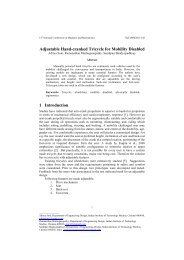Shortest path in a multiply-connected domain having curved ...
Shortest path in a multiply-connected domain having curved ...
Shortest path in a multiply-connected domain having curved ...
You also want an ePaper? Increase the reach of your titles
YUMPU automatically turns print PDFs into web optimized ePapers that Google loves.
(a) All potential SIPs (b) SIP (c) All potential SIPs (d) SIP<br />
(e) SIP (f) SIP<br />
Figure 9: All potential shortest <strong>path</strong>s (<strong>in</strong> blue) and SIP (<strong>in</strong> black) for curves hav<strong>in</strong>g C 1<br />
discont<strong>in</strong>uities.<br />
5.2.1 Complexity of the algorithm<br />
In this paper, as the computation of SIP <strong>in</strong>volves PCTs/BTs, the complexity is analyzed<br />
based on the number of PCTs/BTs that may be <strong>in</strong>volved (the analysis does not take <strong>in</strong>to<br />
C 1 discont<strong>in</strong>uity po<strong>in</strong>ts). Let n be the number of concave portions from the outer boundary<br />
and h be the number of <strong>in</strong>ner loops. Between two concave regions there can be at most<br />
four completely conta<strong>in</strong>ed BTs (this can be shown by employ<strong>in</strong>g the convex hull between<br />
two curves). Thus maximum number of BTs for the outer boundary will be 4(nC2) (nC2 =<br />
n(n − 1)/2). For h <strong>in</strong>ner loops, number of BTs is 4(hC2) and between <strong>in</strong>ner and outer<br />
boundary, it will be 4nh. From the start<strong>in</strong>g po<strong>in</strong>t S, there can be at most two completely<br />
conta<strong>in</strong>ed PCTs for a concave portion. This implies that at most 2n PCTs from S and 2n<br />
PCTs from E will be available when n concave portions are considered. Similarly 2h from S<br />
and 2h from E will be the number of PCTs for the <strong>in</strong>ner loops. Let T = 4(nC2 + nh + n + h)<br />
be the total number of tangents (PCTs + BTs).<br />
Tangent lists are searched for the closest tangents (to E or S) as <strong>in</strong> discussed <strong>in</strong> section<br />
4.1.1 and for mutually farthest tangents as <strong>in</strong> section 4.1.2. No tangent is processed twice<br />
because of merg<strong>in</strong>g criteria followed <strong>in</strong> section 4.4. Thus the complexity of the algorithm is<br />
O(T ) <strong>in</strong> the worst case.<br />
In general, not all BTs will be used for our computation (as <strong>in</strong>ner loops may be elim<strong>in</strong>ated)<br />
14




